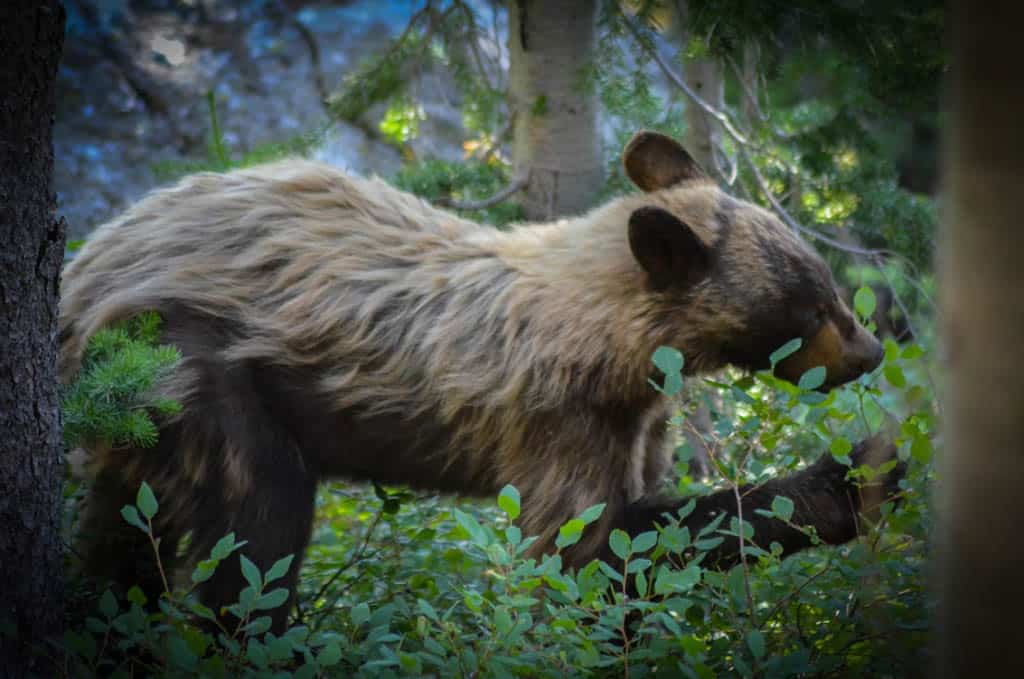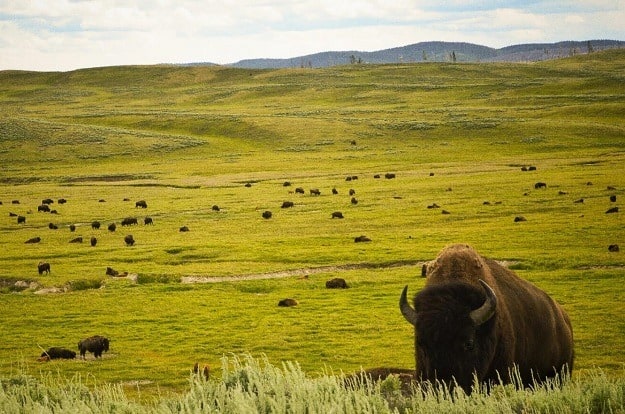If we forget the fact that there is a potential danger of the explosion of this super volcano, there are several realistic Yellowstone dangers we should be aware of:
Obsah / Contents
1) The bears
I was really scared about the bears before we came to the Yellowstone. What to do in case of confrontation? How to defend yourself? Fortunately, local rangers know a lot about bears so we found out several useful tips:
Hike in Groups
Hiking in groups of 3 or more people is the safest way to avoid the bear confrontation. There was not a single bear attack recorded on such a big group.
Carry a Bear Spray
In any case, it is always good to carry a bear spray – bear pepper spray or bear detergent. There is also one funny story connected with a bear spray, which locals told us: One day some guest of Old Faithful Inn hotel used this spray on a mosquito inside the hotel room. They had to evacuate the entire floor of this hotel because of it. This example can tell a lot about its effectiveness.
Be Noisy
We also had to get used to being loud in the forest. Well, if I compare it to our habits, we always stay quite in Czech forests, to respect nature and don’t disturb animals. If you have similar habits in your country - forget about them! Try to make as much noise as you can to alert a bear that you are close to and give him time to choose a different direction. Clap with your hands, whistle, talk loudly, or have a bell attached to your backpack.

Never run
You shouldn’t run in the woods – bears are automatically interested in everything which is moving fast. It alerts their instinct to hunt! In 2015, a bear killed an employee who went for a run just by himself.
In case of bear confrontation, don’t even try to climb a tree - grizzly can climb anywhere. Black bear can climb only on the branches but honestly, hardly any regular visitor (shocked by the confrontation with a bear) can surely identify what kind of bear it is and at the same time look for a suitable tree, which has branches that can hold a man, but not a bear.
Don't go too close
In case you see a bear nearby, you shouldn’t approach him – in any case! 100 m is a sufficient distance. The last rescue advice is: lie down on your stomach, pretend to be dead and protect your head.
If you sleep in the wood, you have to hang on a tree or close in special bear boxes (tin containers placed near campsites) all food and anything that produces any odor.
2) Bison... or just a human stupidity?
The number of injuries in the Yellowstone National Park recently increased because of bison attacks. But is bison really that dangerous animal? Not at all (if you keep an advised distance of 25 yards). Bison is basically a huge, furry cow, who doesn’t care if it's walking in the middle of the road and the whole line of cars has to wait.
The general recommendation is not to approach the bison closer than 25 yards (about 23 meters). Bison hate selfie-craving people who approach them very close or those who want even to pet them. Yes, most accidents were caused because people wanted to take a “cool” selfie with bison. I bet you don’t want to meet an angry bison.
3) Geysers
Yellowstone geysers are extremely acidic. Nobody wants to fell in. In 2016, a ranger died because of the ground cave in. Only the clothes were left behind. Therefore, no one should leave boardwalks or marked paths. You never know how thick is the ground you are standing at, it can be only a few centimeters thin. In case you get to the geothermal area without any marked trails, try to follow bison scat, because where the bison didn’t crush in, so wouldn’t you.
You can recognize the geothermal area easily – it can be identified by a white/ creamy gravel. There are no trees or plants growing in this area.

4) Poisonous plants
There are several deadly poisonous plants in the Yellowstone National park. Simple advice is: don’t eat anything you aren’t 100% sure you know. In the past years, the whole family has died of poisoning themselves after adding one of the poisonous plants to the soup. The most dangerous plant is Hemlock, so-called meadow death. According to the rangers, a simple touch can cause allergic reactions to the skin.
5) Snakes
You can find six kinds of snakes in Yellowstone. I had the opportunity to see only 2 kinds, which were not poisonous. The only poisonous one is Prairie Rattlesnake. Fortunately, this rattlesnake occurs only in a small Northern area of Yellowstone. The general recommendation is: don’t sit on the stones under which can be Rattlesnakes hidden.
Despite all these nontraditional dangers it’s appropriate to say that, the human factor is still the biggest threat, especially while driving.
Check this beautiful video about Road trip around USA national parks:
Share this blog post for your friends:

